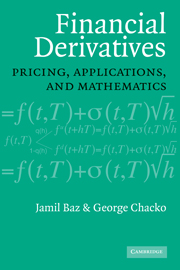Crossref Citations
This Book has been
cited by the following publications. This list is generated based on data provided by Crossref.
Tunaru, Radu
Clark, Ephraim
and
Viney, Howard
2005.
An option pricing framework for valuation of football players.
Review of Financial Economics,
Vol. 14,
Issue. 3-4,
p.
281.
2006.
Finanzmarktstatistik.
p.
239.
Treussard, Jonathan
2006.
The Non-Monotonicity of Value-at-Risk and the Validity of Risk Measures over Different Horizons.
SSRN Electronic Journal,
Treussard, Jonathan
2007.
Life-Cycle Consumption Plans and Portfolio Policies in a Heath-Jarrow-Morton Economy.
SSRN Electronic Journal,
Ruffino, Doriana
and
Treussard, Jonathan
2007.
Financial Frictions and Risky Corporate Debt.
SSRN Electronic Journal,
Ruffino, Doriana
and
Treussard, Jonathan
2007.
Financial Frictions and Risky Corporate Debt.
Economic Notes,
Vol. 36,
Issue. 1,
p.
77.
Azar, Samih Antoine
2007.
A duration-based equity premium.
Applied Financial Economics Letters,
Vol. 3,
Issue. 6,
p.
409.
Grigoriev, Alexander
van Loon, Joyce
and
Uetz, Marc
2008.
Internet and Network Economics.
Vol. 5385,
Issue. ,
p.
362.
2008.
Macrofinancial Risk Analysis.
p.
43.
2008.
Macrofinancial Risk Analysis.
p.
129.
Taleb, Nassim Nicholas
2009.
Finiteness of variance is irrelevant in the practice of quantitative finance.
Complexity,
Vol. 14,
Issue. 3,
p.
66.
Medeiros, Carlos I.
and
He, Ying
2011.
An Assessment of Estimates of Term Structure Models for the United States.
IMF Working Papers,
Vol. 11,
Issue. 247,
p.
1.
Vasudev, P M
2014.
Credit derivatives and the Dodd–Frank Act: Is the regulatory response appropriate?.
Journal of Banking Regulation,
Vol. 15,
Issue. 1,
p.
56.
2014.
Problems and Solutions in Mathematical Finance.
p.
365.
Okelola, M. O.
Govinder, K. S.
and
O'Hara, J. G.
2015.
Solving a partial differential equation associated with the pricing of power options with time‐dependent parameters.
Mathematical Methods in the Applied Sciences,
Vol. 38,
Issue. 14,
p.
2901.
Choe, Geon Ho
2016.
Stochastic Analysis for Finance with Simulations.
p.
137.
Choe, Geon Ho
2016.
Stochastic Analysis for Finance with Simulations.
p.
225.
Choe, Geon Ho
2016.
Stochastic Analysis for Finance with Simulations.
p.
177.
Choe, Geon Ho
2016.
Stochastic Analysis for Finance with Simulations.
p.
421.
Choe, Geon Ho
2016.
Stochastic Analysis for Finance with Simulations.
p.
297.





